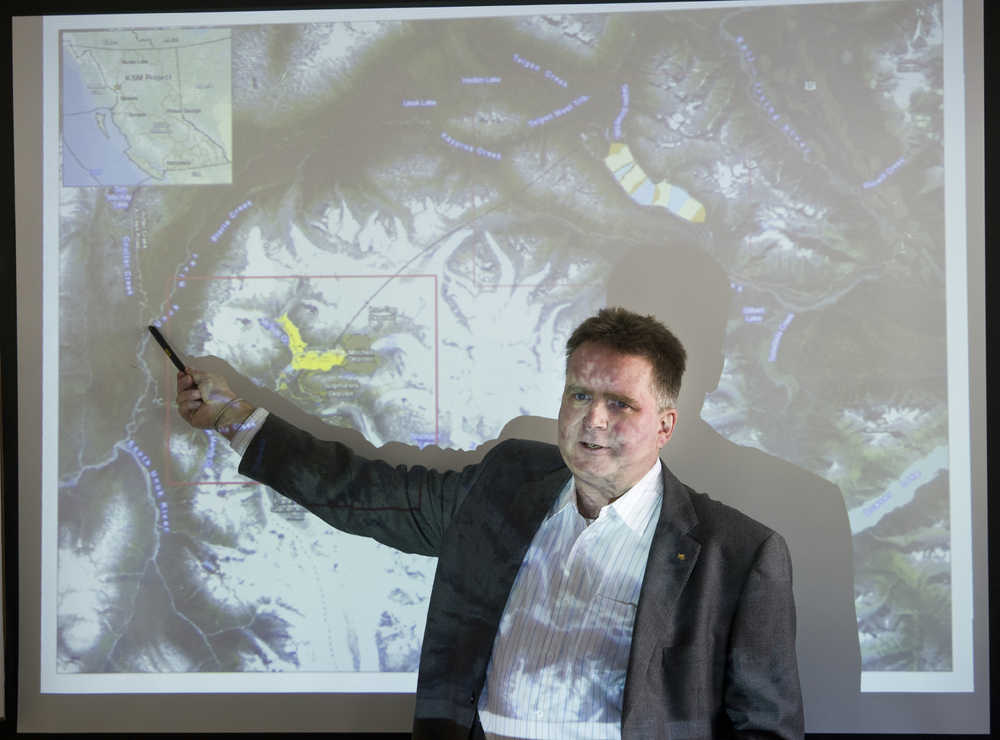In a few weeks, survey crews will again be working on British Columbia mountainsides that could one day be home to one of the world’s largest gold and copper mines, but construction of that mine isn’t likely anytime soon.
On Wednesday, Seabridge Gold vice president Brent Murphy updated members of the Juneau Chamber of Commerce and Juneau Economic Development Council on the progress of the controversial Kerr-Sulphurets-Mitchell mine near the headwaters of the Unuk River.
“We are not going away. There will be a mining project. KSM will be built one of these days,” Murphy told a small group in the offices of Southeast Conference.
[Environmental groups: KSM a bad investment.]
Thanks to falling global mineral prices, “these days” are seemingly later, rather than sooner.
While exploratory drilling continues, Seabridge is still seeking a partner to develop its mine.
“Our primary objective continues to be to complete a joint venture agreement on the KSM project with a suitable partner on terms advantageous to Seabridge,” the company’s 2015 annual report stated. “This objective is mostly not under our control.”
According to a 2012 financial feasibility study, an investment of $5.256 billion will be needed to develop the mine. That titanic figure means Seabridge needs support from one of the world’s 10 largest gold and mining corporations, the company stated in its annual report, released three weeks ago.
As global metal prices have plunged amid economic trouble in China and other developing nations, “market conditions and industry confidence are key factors affecting the achievement of this objective,” the company declared.
If the company can find a partner, the payoff would be huge. According to the latest figures published by Coeur Mining, the Kensington Gold Mine has proven reserves of 67,000 ounces of gold and another 493,000 ounces in probable reserves.
KSM has 10,300,000 ounces of proven reserves and another 27,900,000 ounces of probable reserves. And that’s just the gold — KSM also has the potential for nearly 10 million pounds of copper, 191 million ounces of silver and 213 million pounds of molybdenum, a mineral used in electronic components and to harden steel.
That promise comes at a cost. Environmental groups have consistently opposed plans for the mine. While KSM does not intersect any salmon-bearing rivers or streams, it is upstream of the Unuk River, which flows through the Misty Fjords National Wilderness and into the Pacific Ocean north of Ketchikan.
[Part 1 of 3: Anti-KSM groups seek federal help.]
Fishermen have expressed concerns that runoff from the mine could contaminate the Unuk, harming salmon runs. Those concerns intensified after a tailings dam failed at the Mount Polley Mine in August 2014, contaminating British Columbia rivers and lakes.
[Mount Polley to reopen after 2014 disaster.]
Last week, the auditor general of British Columbia, Carol Bellringer, issued a report faulting the owners of another British Columbia mine, the Tulsequah Chief, for failing to stop the flow of acidic water from the mine and into the Taku River, which flows just south of Juneau.
“What we learned last week from the auditor-general is that the BC process is not the best in the world,” said Chris Zimmer, the Alaska campaign manager for Rivers Without Borders, which has opposed the KSM mine.
Murphy said the results of the auditor general report will have implications for KSM, too. “I think you will absolutely see changes coming. We know there are changes coming,” he said. “There will be stricter regulation. Of that, I have no doubt.”
[Tulsequah Chief Mine Owner defaults on debt payment, critics wonder about cleanup responsibility.]
While Zimmer has problems with KSM’s plans, he doesn’t think the mine is likely anytime soon.
“It’s a very, very complex project, and I’m sure investors are going to take a real hard look before they spend money,” he said. “I wouldn’t be optimistic about getting that kind of money in the coming years.”
• Contact reporter James Brooks at james.k.brooks@juneauempire.com.
Related stories:
Empire Editorial: KSM: Leaving Alaskans with all the risk, zero benefits
My Turn: Doing mining differently up north

